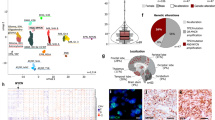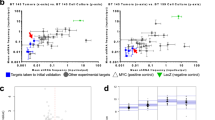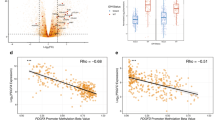Abstract
Glioblastoma (GBM) is a highly lethal brain tumour presenting as one of two subtypes with distinct clinical histories and molecular profiles. The primary GBM subtype presents acutely as a high-grade disease that typically harbours mutations in EGFR, PTEN and INK4A/ARF (also known as CDKN2A), and the secondary GBM subtype evolves from the slow progression of a low-grade disease that classically possesses PDGF and TP53 events1,2,3. Here we show that concomitant central nervous system (CNS)-specific deletion of p53 and Pten in the mouse CNS generates a penetrant acute-onset high-grade malignant glioma phenotype with notable clinical, pathological and molecular resemblance to primary GBM in humans. This genetic observation prompted TP53 and PTEN mutational analysis in human primary GBM, demonstrating unexpectedly frequent inactivating mutations of TP53 as well as the expected PTEN mutations. Integrated transcriptomic profiling, in silico promoter analysis and functional studies of murine neural stem cells (NSCs) established that dual, but not singular, inactivation of p53 and Pten promotes an undifferentiated state with high renewal potential and drives increased Myc protein levels and its associated signature. Functional studies validated increased Myc activity as a potent contributor to the impaired differentiation and enhanced renewal of NSCs doubly null for p53 and Pten (p53-/- Pten-/-) as well as tumour neurospheres (TNSs) derived from this model. Myc also serves to maintain robust tumorigenic potential of p53-/- Pten-/- TNSs. These murine modelling studies, together with confirmatory transcriptomic/promoter studies in human primary GBM, validate a pathogenetic role of a common tumour suppressor mutation profile in human primary GBM and establish Myc as an important target for cooperative actions of p53 and Pten in the regulation of normal and malignant stem/progenitor cell differentiation, self-renewal and tumorigenic potential.
This is a preview of subscription content, access via your institution
Access options
Subscribe to this journal
Receive 51 print issues and online access
$199.00 per year
only $3.90 per issue
Buy this article
- Purchase on Springer Link
- Instant access to full article PDF
Prices may be subject to local taxes which are calculated during checkout




Similar content being viewed by others
References
Kleihues, P. & Ohgaki, H. Primary and secondary glioblastomas: from concept to clinical diagnosis. Neuro-oncol. 1, 44–51 (1999)
Zhu, Y. & Parada, L. F. The molecular and genetic basis of neurological tumours. Nature Rev. Cancer 2, 616–626 (2002)
Furnari, F. B. et al. Malignant astrocytic glioma: genetics, biology, and paths to treatment. Genes Dev. 21, 2683–2710 (2007)
Wiedemeyer, R. et al. Feedback circuit among INK4 tumor suppressors constrains human glioblastoma development. Cancer Cell 13, 355–364 (2008)
Zhuo, L. et al. hGFAP-cre transgenic mice for manipulation of glial and neuronal function in vivo . Genesis 31, 85–94 (2001)
Zhu, Y. et al. Early inactivation of p53 tumor suppressor gene cooperating with NF1 loss induces malignant astrocytoma. Cancer Cell 8, 119–130 (2005)
Jonkers, J. et al. Synergistic tumor suppressor activity of BRCA2 and p53 in a conditional mouse model for breast cancer. Nature Genet. 29, 418–425 (2001)
Louis, D. N., Ohgaki, H., Wiestler, O. D. & Cavenee, W. K. WHO Classification of Tumours of the Central Nervous System 4th edn (eds Louis, D. N., Ohgaki, H., Wiestler, O.D. & Cavenee, W.K.) (World Health Organization, 2007)
Watanabe, K. et al. Overexpression of the EGF receptor and p53 mutations are mutually exclusive in the evolution of primary and secondary glioblastomas. Brain Pathol. 6, 217–223 (1996)
Ohgaki, H. et al. Genetic pathways to glioblastoma: a population-based study. Cancer Res. 64, 6892–6899 (2004)
Fukushima, T. et al. Genetic alterations in primary glioblastomas in Japan. J. Neuropathol. Exp. Neurol. 65, 12–18 (2006)
Stommel, J. M. et al. Coactivation of receptor tyrosine kinases affects the response of tumor cells to targeted therapies. Science 318, 287–290 (2007)
Ligon, K. L. et al. Olig2-regulated lineage-restricted pathway controls replication competence in neural stem cells and malignant glioma. Neuron 53, 503–517 (2007)
Groszer, M. et al. PTEN negatively regulates neural stem cell self-renewal by modulating G0–G1 cell cycle entry. Proc. Natl Acad. Sci. USA 103, 111–116 (2006)
Gil-Perotin, S. et al. Loss of p53 induces changes in the behavior of subventricular zone cells: implication for the genesis of glial tumors. J. Neurosci. 26, 1107–1116 (2006)
Meletis, K. et al. p53 suppresses the self-renewal of adult neural stem cells. Development 133, 363–369 (2006)
Yang, L. et al. Akt/protein kinase B signaling inhibitor-2, a selective small molecule inhibitor of Akt signaling with antitumor activity in cancer cells overexpressing Akt. Cancer Res. 64, 4394–4399 (2004)
Patel, J. H., Loboda, A. P., Showe, M. K., Showe, L. C. & McMahon, S. B. Analysis of genomic targets reveals complex functions of MYC. Nature Rev. Cancer 4, 562–568 (2004)
Cartwright, P. et al. LIF/STAT3 controls ES cell self-renewal and pluripotency by a Myc-dependent mechanism. Development 132, 885–896 (2005)
Takahashi, K. & Yamanaka, S. Induction of pluripotent stem cells from mouse embryonic and adult fibroblast cultures by defined factors. Cell 126, 663–676 (2006)
Ben-Porath, I. et al. An embryonic stem cell-like gene expression signature in poorly differentiated aggressive human tumors. Nature Genet. 40, 499–507 (2008)
Wong, D. J. et al. Module map of stem cell genes guides creation of epithelial cancer stem cells. Cell Stem Cell 2, 333–344 (2008)
Ho, J. S., Ma, W., Mao, D. Y. & Benchimol, S. p53-Dependent transcriptional repression of c-myc is required for G1 cell cycle arrest. Mol. Cell. Biol. 25, 7423–7431 (2005)
Gera, J. F. et al. AKT activity determines sensitivity to mammalian target of rapamycin (mTOR) inhibitors by regulating cyclin D1 and c-myc expression. J. Biol. Chem. 279, 2737–2746 (2004)
Sears, R. et al. Multiple Ras-dependent phosphorylation pathways regulate Myc protein stability. Genes Dev. 14, 2501–2514 (2000)
Bredel, M. et al. Functional network analysis reveals extended gliomagenesis pathway maps and three novel MYC-interacting genes in human gliomas. Cancer Res. 65, 8679–8689 (2005)
Clarke, M. F. et al. Cancer stem cells–perspectives on current status and future directions: AACR Workshop on cancer stem cells. Cancer Res. 66, 9339–9344 (2006)
Lobo, N. A., Shimono, Y., Qian, D. & Clarke, M. F. The biology of cancer stem cells. Annu. Rev. Cell Dev. Biol. 23, 675–699 (2007)
Piccirillo, S. G. et al. Bone morphogenetic proteins inhibit the tumorigenic potential of human brain tumour-initiating cells. Nature 444, 761–765 (2006)
Lee, J. et al. Epigenetic-mediated dysfunction of the bone morphogenetic protein pathway inhibits differentiation of glioblastoma-initiating cells. Cancer Cell 13, 69–80 (2008)
Bachoo, R. M. et al. Epidermal growth factor receptor and Ink4a/Arf: convergent mechanisms governing terminal differentiation and transformation along the neural stem cell to astrocyte axis. Cancer Cell 1, 269–277 (2002)
Rietze, R. L. & Reynolds, B. A. Neural stem cell isolation and characterization. Methods Enzymol. 419, 3–23 (2006)
Maser, R. S. et al. Chromosomally unstable mouse tumours have genomic alterations similar to diverse human cancers. Nature 447, 966–971 (2007)
Li, C. & Wong, W. H. Model-based analysis of oligonucleotide arrays: expression index computation and outlier detection. Proc. Natl Acad. Sci. USA 98, 31–36 (2001)
Tusher, V. G., Tibshirani, R. & Chu, G. Significance analysis of microarrays applied to the ionizing radiation response. Proc. Natl Acad. Sci. USA 98, 5116–5121 (2001)
Acknowledgements
We thank A. Berns for providing p53L mice; S. Zhou and S. Jiang for mouse husbandry and care; R. T. Bronson for discussion on pathology analysis; K. Montgomery for discussion on sequencing; and Y.-H. Xiao, B. Feng and J. Zhang for bioinformatic help. H.Z. was supported by Helen Hay Whitney Foundation. H. Ying is a recipient of the Marsha Mae Moeslein Fellowship from the American Brain Tumor Association. A.C.K. is a recipient of the Leonard B. Holman Research Pathway Fellowship. Z.D. is supported by the Damon Runyon Cancer Research Foundation. J.M.S. is supported by a Ruth L. Kirschstein National Research Service Award Fellowship. R.W. is supported by a Mildred Scheel Fellowship (Deutsche Krebshilfe). Grant support comes from the Goldhirsh Foundation (R.A.D.), and NIH grants U01 CA84313 (R.A.D.), RO1CA99041 (L.C.) and 5P01CA95616 (R.A.D., L.C., W.H.W., C.B. and K.L.L.). R.A.D. is an American Cancer Society Research Professor supported by the Robert A. and Renee E. Belfer Foundation Institute for Innovative Cancer Science.
Author Contributions H.Z. and H. Ying performed the experiments and contributed equally as first authors. R.A.D. supervised experiments and contributed as senior author. M.J.Y. generated the PtenL mouse allele. D.J.H., W.H.W. and G.T. conducted the microarray and promoter analyses. K.L.L., H.Z. and G.C.C. provided the pathology analyses. H. Yan, A.C.K., A.-J.C., S.R.P., Z.D., J.M.S, K.L.D. and R.W. performed the experiments. C.B. contributed patient samples and pathologic information. L.C. and Y.A.W. contributed to the writing of the manuscript.
Author information
Authors and Affiliations
Corresponding author
Supplementary information
Supplementary Information
This file contains Supplementary Figures 1-13 with Legends and Supplementary Tables 1 and 2 (PDF 18476 kb)
Rights and permissions
About this article
Cite this article
Zheng, H., Ying, H., Yan, H. et al. p53 and Pten control neural and glioma stem/progenitor cell renewal and differentiation. Nature 455, 1129–1133 (2008). https://doi.org/10.1038/nature07443
Received:
Accepted:
Issue Date:
DOI: https://doi.org/10.1038/nature07443
This article is cited by
-
Growth factor independence underpins a paroxysmal, aggressive Wnt5aHigh/EphA2Low phenotype in glioblastoma stem cells, conducive to experimental combinatorial therapy
Journal of Experimental & Clinical Cancer Research (2022)
-
Modelling aggressive prostate cancers of young men in immune-competent mice, driven by isogenic Trp53 alterations and Pten loss
Cell Death & Disease (2022)
-
Glioblastoma multiforme in patients with human immunodeficiency virus: an integrated review and analysis
Journal of Neuro-Oncology (2022)
-
IDP-410: a Novel Therapeutic Peptide that Alters N-MYC Stability and Reduces Angiogenesis and Tumor Progression in Glioblastomas
Neurotherapeutics (2022)
-
Upregulation of KIF11 in TP53 Mutant Glioma Promotes Tumor Stemness and Drug Resistance
Cellular and Molecular Neurobiology (2022)
Comments
By submitting a comment you agree to abide by our Terms and Community Guidelines. If you find something abusive or that does not comply with our terms or guidelines please flag it as inappropriate.



